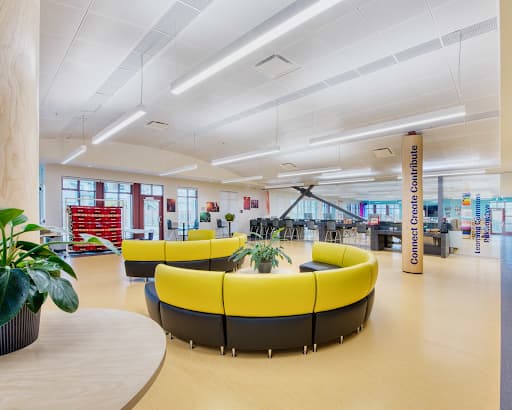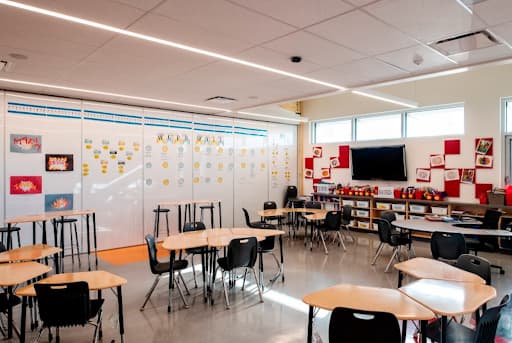Creating Classroom Capacity: The Role of Furniture and Design
September 7, 2023
%20(1).jpg)
It’s back-to-school season, bringing a September brimming with the busy scramble of new routines. Both students and teachers alike are preparing for the new school year; shopping for supplies and planning for the year ahead. Adding to this hustle is the now all too familiar question of class sizes.
With over-enrollment, fewer teachers, and continued underfunding becoming the norm, students are left wondering just how many others will share their classroom. Parents are left questioning how much support their children will receive, while teachers are worrying about how they will manage it all.
Though it may seem impossible to generate space where there is none, new trends and developments in the area of classroom design are developing; ultimately generating additional capacity and prioritizing positive learning outcomes. Long-term efforts to create functional spaces for students to learn include proper planning and design, creating opportunities where once were challenges. Resilient in their commitment to student-centered growth, classrooms are emerging as effective spaces for teaching, learning, and continued development.
The Effects of Classroom Capacity
Overcrowded classrooms can have a harmful effect on both teachers and students, an unfortunate symptom of decreased funding across Canada. From less individualized instruction to greater distractions and detrimental noise levels, filling classrooms with more students than intended can affect a teacher’s ability to instruct effectively and can impact students’ learning.
Here are just some of the negative consequences of overcrowded classrooms:
- Additional strain is placed on teachers in overcrowded settings, resulting in reduced quality of student-teacher interaction.
- Individualized attention becomes rare, if not impossible. With too many students, teachers are left unable to provide the support and resources students need to thrive.
- With limited access to assistance and advocacy due to overwhelm and space, students and teachers are left unmotivated, with attendance levels affected.
The reduced attendance levels wrought by overcrowded classrooms have a direct impact on funding levels, given attendance rates often play a role in determining funding received. Though these challenges may seem insurmountable, the role of furniture in capacity planning is becoming increasingly important, with cutting-edge designs paving the way towards a more effective learning environment for all.
Revolutionizing Classrooms with Furniture
Traditional classrooms were historically static, replete with rows of desks and chairs, operating under the assumption that one size fits all. Classroom furniture has come a long way since then, with next-generation learning environments demanding the exploration of the connections between learning, movement, and adaptability.
Compounding the importance of setup is the overcrowding of classrooms, necessitating a new vision for design. With a variety of seating and work surface options now available, learning environments can comprise multiple zones that not only support a wide variety of activities but help to reduce crowding, creating flexible spaces to help students flourish. Reconfigurable furniture and spaces enable different group sizes and workflows, from individual learning to small group and full classroom teaching.

- How can furniture enhance the delivery of the curriculum?
- In what ways does the furniture support multifunction environments
- How can new furniture create opportunities for student representation?
- How does the furniture selection meet the individual needs of the students?
- How can furniture selection best maximize the space available, coupled with the number of students contained within?
The desired outcome of the collaborative process is to select flexible and multi-use furniture for students and staff; options that enhance the space including soft seating to create versatile environments that meet the needs of students and teachers. Furniture that can multi-task to enhance collaboration such as white-board tables and circular shapes coupled with multi-configurable design including easily stored workspaces are just some of the options available.
The Power of Multi-Functional Spaces
The impact of school furniture on academic and social-emotional development and learning is undeniable. Students interact with furniture more than any other design element, expanding the opportunity for good design and planning to significantly affect the environment. With the ability to create learning zones, the importance of furniture cannot be understated; it can bring students together, promote collaboration, and help learners think and focus.
In order to maximize the implications of square-spaced classrooms, perhaps the most important element of new cutting-edge designs is flexibility coupled with modularity. These elements promote an inclusive approach to learning, helping both students and teachers alike to align classroom setup based on learning needs and outcomes.
Reading corners for individual study, quiet zones for focused tasks, wobble stools and standing tables for movement, and mobile partitions for adaptable layouts are just some of the examples of ways furniture can help a classroom expand. A prime example of using flexible furniture is CDI’s recently completed Huntsville School outfitting project. School classrooms became multi-taskers, with tabletops in the shape of trapezoids with multiple configurations based on learning objectives. Science and project spaces were outfitted with whiteboard table tops that move depending on the space's needs, while furniture in the shapes of circles, S curves, and partial curves were added as workspaces.

With overcrowding becoming the norm, schools are being forced to rethink classroom set-up and design. However, by taking an inclusive approach to classroom function and setup, outcomes can be improved for current and future learners.
Cutting-edge furniture and flexible options are already yielding positive results, helping to maximize both space and functionality. Adaptable zones and areas with soft, moveable, and transitional seating can result in students being more willing to learn and work, enhancing educational outcomes. When capacity is created within a classroom, students are given back motivation and teachers can use the space to expand, resulting in a positive learning environment for all.
Ready to get started? Meet with a CDI design consultant today.

